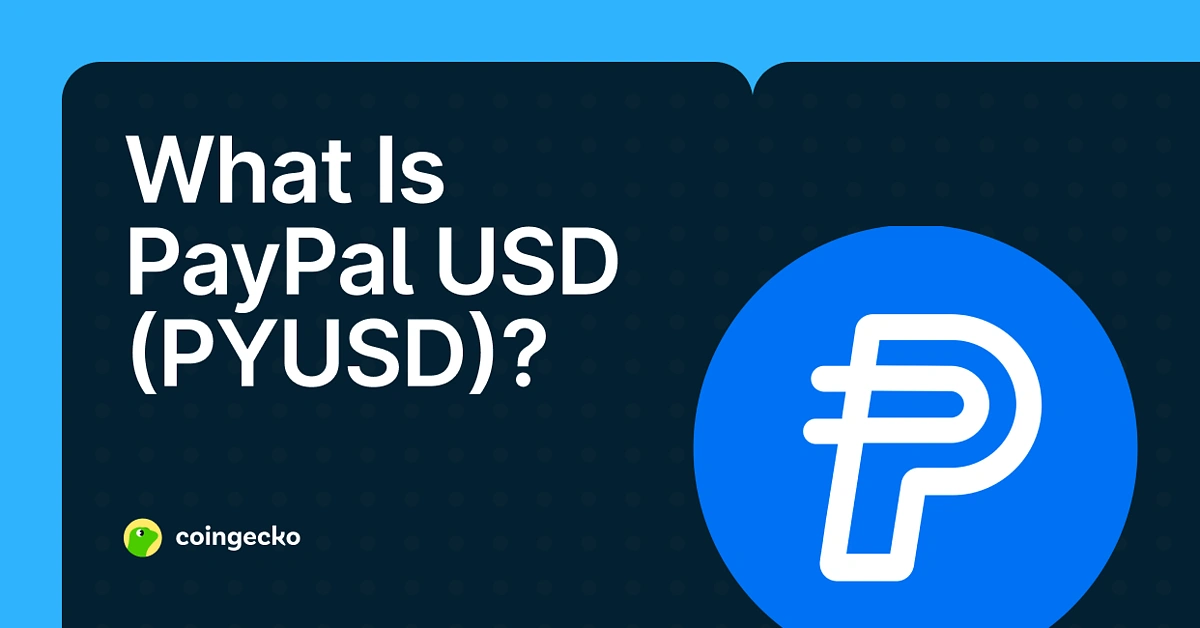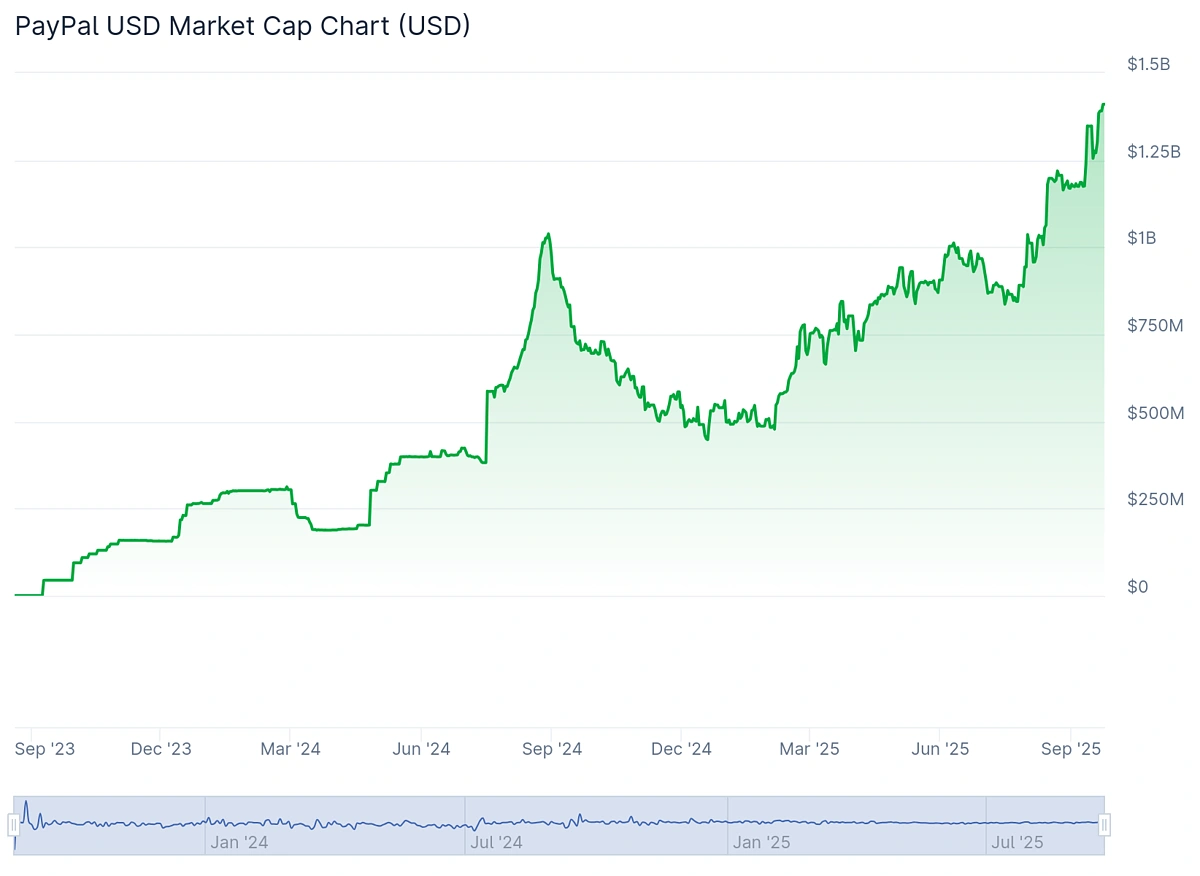PayPal USD (PYUSD) Overview

In August 2023, PayPal launched PayPal USD (PYUSD), marking a significant moment when one of the world’s largest traditional finance companies embraced stablecoin technology, aiming to build a bridge between established financial systems and the emerging Web3 ecosystem.
PYUSD joins a stablecoin market that has grown to almost $300 billion in total value, with these digital dollars becoming essential infrastructure for crypto trading, DeFi applications, and increasingly, everyday payments. As regulatory clarity improves through initiatives like the proposed GENIUS Act, stablecoins are transitioning from crypto-native tools to mainstream financial products.
What Is PYUSD
PYUSD is a stablecoin designed to maintain a stable 1:1 value with the U.S. dollar. For every PYUSD token in circulation, there’s an equivalent value held in reserve consisting of U.S. dollar deposits, short-term U.S. Treasuries, and similar cash equivalents. This backing mechanism ensures 1 PYUSD can always be bought or sold for 1 USD through PayPal, providing the price stability necessary for practical payment use cases, unlike the volatility present in cryptocurrencies like BTC or ETH.
The strategic significance of PYUSD extends beyond just another cryptocurrency launch. By integrating PYUSD into its core payment infrastructure, PayPal validates stablecoin technology for mainstream use, potentially accelerating both adoption and regulatory clarity worldwide.
How Does PYUSD Work?
Now, let’s look at how PYUSD works and how it balances security with usability.
Issuance and Regulation
While PYUSD is a PayPal-branded product, Paxos Trust Company serves as the official issuer and custodian. Paxos operates as a limited-purpose trust company under direct regulatory supervision of the New York State Department of Financial Services (NYDFS), placing PYUSD within one of the most stringent U.S. regulatory frameworks for digital assets.
The token lifecycle follows a controlled minting and burning process. When institutions want to acquire PYUSD, they send U.S. dollars to Paxos, which then mints corresponding PYUSD tokens. For redemptions, holders send tokens back to Paxos, which burns them and returns equivalent U.S. dollars. This mechanism ensures the total PYUSD supply remains fully backed by reserve assets.
Reserve Model and Transparency
PYUSD’s reserves consist exclusively of high-quality, liquid instruments: U.S. dollar deposits at insured institutions, U.S. Treasuries, and U.S. Treasury reverse repurchase agreements, avoiding riskier assets like corporate bonds or other digital currencies. This conservative approach minimizes the risk of reserve value loss, ensuring redemptions can always be met.
Paxos publishes monthly reserve reports detailing the composition of backing assets, with independent attestations from KPMG, one of the “Big Four” accounting firms. This engagement with a top-tier auditor builds credibility and differentiates PYUSD from competitors with less transparent reserve practices.
Multi-Chain Strategy
PYUSD now operates across 13 blockchain networks following major expansions in September 2025. The original deployment included Ethereum, Solana, Arbitrum, and Stellar, but PayPal’s partnership with LayerZero significantly broadened accessibility.
Through LayerZero’s integration announced September 18, 2025, PYUSD expanded to nine additional blockchains: Abstract, Aptos, Avalanche, Ink, Sei, Stable, Tron, plus upgraded versions on Berachain and Flow. This creates “PYUSD0″—a permissionless version that maintains full fungibility across all supported networks through LayerZero’s Omnichain Fungible Token standard.
Current blockchain presence:
-
Ethereum: Provides deep security, liquidity, and DeFi ecosystem integration for collateral and trading.
-
Solana, Arbitrum, Stellar: Address Ethereum’s high gas fees with low-cost transactions for payments and remittances.
-
Tron, Avalanche, Aptos: Enable access to high-volume stablecoin markets and emerging DeFi ecosystems.
-
Abstract, Ink, Sei, Stable: Target specialized use cases from gaming to cross-border payments.
This multi-chain approach allows PYUSD to offer Ethereum’s security and DeFi compatibility while providing the speed and cost-efficiency needed for mass-market payment applications across diverse blockchain ecosystems.
Smart Contract Features
PYUSD’s smart contract includes several centralized administrative functions:
-
Pause: Halts all on-chain transfers during security threats
-
Freeze: Prevents specific addresses from moving funds
-
Wipe: Permanently removes tokens from frozen addresses
While these features contradict cryptocurrency’s decentralization ideals, they’re necessary for regulatory compliance. The ability to respond to legal orders, such as court-mandated asset freezes or sanctions enforcement, is essential for a regulated stablecoin. These controls make PYUSD “institution-ready” and are standard features in other major centralized stablecoins like USDC and USDT.
PYUSD in the PayPal Ecosystem
While PYUSD’s technology and regulatory framework are robust, its main strategic asset is its native integration into one of the world’s largest consumer and merchant payment networks.
Integration with PayPal and Venmo
PYUSD’s primary competitive advantage lies in its seamless integration with PayPal and Venmo applications. Eligible U.S. users can buy, sell, and hold PYUSD using existing PayPal balances or linked bank accounts, removing the friction typically associated with entering the crypto ecosystem.
Sending PYUSD between PayPal and Venmo users is instantaneous and free, making it highly efficient for peer-to-peer payments (do note that gas fees still apply when transferring PYUSD to an external crypto wallet). This integration provides direct access to over 400 million active accounts, creating an unparalleled pathway for mainstream adoption.
September 2025: Peer-to-Peer Crypto Payments Launch
On September 15, 2025, PayPal launched a major expansion of its P2P capabilities by integrating cryptocurrency transfers into its payment system. The new feature introduces “PayPal Links”—personalized payment links that users can share to request or send Bitcoin, Ethereum, PYUSD, and other compatible digital assets.
This functionality extends beyond the PayPal ecosystem, allowing users to send cryptocurrency to external crypto-compatible wallets globally. The feature launched first in the United States, with expansion to the United Kingdom and Italy planned for later in 2025.
To encourage adoption, personal transfers between friends and family remain exempt from IRS 1099-K tax reporting requirements, keeping gifts and expense splitting tax-free.
Key Use Cases
This integration enables several key use cases that align with PayPal’s core business:
Peer-to-Peer Payments: Instant, fee-free transfers between PayPal and Venmo users.
E-commerce: Users can select PYUSD at checkout on PayPal-accepting websites through “Checkout with Crypto,” with transactions covered by PayPal’s Purchase Protection policy.
Cross-Border Remittances: Leverages blockchain technology to offer faster, more transparent, and cheaper alternatives to traditional remittance channels.
Web3 Bridge: Serves as an on-ramp and off-ramp between traditional financial accounts and the Web3 ecosystem.
PYUSD Rewards Program
PayPal offers a rewards program where eligible users earn monthly yields on PYUSD holdings in their accounts, incentivizing users to convert fiat dollars to PYUSD and creates a closed-loop payment system. By encouraging users to hold and spend PYUSD within the network, PayPal can facilitate instant, low-cost transactions while bypassing external payment networks like ACH, Visa, and Mastercard.
PYUSD Market Performance
Since launch, PYUSD has experienced significant growth, particularly accelerating in 2025. The stablecoin’s market capitalization reached approximately $1.4 billion as of September 2025, representing almost 150% growth from roughly $500 million at the start of 2025.

September 2025 Growth Drivers
The stablecoin’s expansion was driven by several factors:
Multi-chain accessibility: LayerZero integration provided access to high-volume networks like Tron, which processes billions in daily stablecoin transfers
Strategic partnerships: PayPal Ventures’ investment in Stable’s $28 million seed round on September 22, 2025, enables PYUSD integration into Stablechain, a Layer 1 network designed specifically for stablecoin transactions
DeFi Integration and Yield Opportunities
PYUSD has maintained active integration with major DeFi protocols including Aave and Curve for lending, borrowing, and yield generation. The most notable growth driver was strategic partnerships with Solana-based lending platforms like Kamino.
Announcing a brand new PYUSD Growth Initiative on Kamino, designed to rapidly & sustainably scale PYUSD on @solana
The first phase kicks off with 700,000 in monthly PYUSD incentives across Kamino Earn, Kamino Lend, and Kamino Liquidity
Rewards scale as deposits increase. pic.twitter.com/P1b0ajNu0E
— Kamino (@KaminoFinance) September 9, 2025
However, PYUSD’s true success metric may not be purely on-chain market capitalization. The strategic purpose is leveraging PayPal and Venmo ecosystem integration to drive adoption from mainstream users, acting as a frictionless on-ramp for 400 million users to convert fiat into on-chain PYUSD.
Competitive Landscape of Stablecoins
|
Stablecoin |
Issuer |
Type |
Key Differentiator |
Primary Risks |
|
PYUSD |
Paxos Trust Company |
Centralized, Fiat-Backed |
PayPal/Venmo 400M+ user integration |
Centralization, custodial risk, smart contract controls |
|
USDT |
Tether Limited |
Centralized, Fiat-Backed |
Deepest liquidity across global exchanges |
Reserve opacity, regulatory risk, smart contract controls |
|
USDC |
Circle |
Centralized, Fiat-Backed |
Strong compliance and institutional trust |
Centralization, custodial risk, smart contract controls |
|
USDe |
Ethena Labs |
Decentralized, Synthetic |
Native yield from delta-neutral hedging |
Funding risk, counterparty risk |
|
USDS |
MakerDAO |
Decentralized, Over-collateralized |
Censorship-resistant governance |
Over-reliance on centralized collateral |
PYUSD vs Major Competitors
Against USDT: PYUSD positions itself as the trust-focused alternative to USDT’s ubiquity, targeting risk-averse users prioritizing safety and regulatory compliance over permissionless access. While USDT dominates crypto trading with deep liquidity, it faces ongoing questions about reserve quality.
Against USDC: This represents the most direct competition, as both are U.S.-regulated stablecoins with similar reserve models. The key difference is distribution strategy–USDC grew through crypto-native DeFi integration and partnership with Coinbase, while PYUSD leverages mainstream consumer access through PayPal’s network.
Against USDe: PYUSD offers simplicity and regulatory certainty with modest yields, while USDe provides potentially higher market-driven yields through complex hedging strategies that introduce funding, counterparty, and smart contract risks.
Against USDS: PYUSD embraces centralized control for regulatory compliance, while USDS maintains decentralized governance through its DAO, though it increasingly relies on centralized assets like USDC for collateral.
Risks and Considerations
Despite its strong backing and regulatory standing, PYUSD is not without risks.
Centralization and Custodial Risks
PYUSD’s dependence on PayPal and Paxos creates concentration risk. Any major issues at either entity—security breaches, insolvency, or adverse regulatory action—could severely impact PYUSD holders. Additionally, the fiat reserves are held by third-party financial institutions, introducing counterparty risk, as demonstrated by USDC’s temporary de-pegging during the Silicon Valley Bank collapse in 2023.
Smart Contract Controls
The freeze and wipe functions fundamentally alter asset ownership compared to decentralized cryptocurrencies. PYUSD holders don’t have absolute control over their funds; assets can be seized based on legal orders.
Regulatory and Competitive Challenges
While PYUSD benefits from NYDFS oversight, the broader U.S. stablecoin regulatory landscape remains fluid. Future federal legislation could introduce new requirements that impact PYUSD’s business model. Additionally, as a late market entrant, PYUSD faces established competitors with strong network effects and deep ecosystem integrations.
The Future of PYUSD and Final Thoughts
PYUSD’s September 2025 developments signal an aggressive expansion strategy focused on mainstream payments and multi-chain accessibility. The combination of peer-to-peer crypto functionality, presence across 13 blockchains, and strategic partnerships creates multiple pathways for adoption while maintaining regulatory compliance.
PayPal USD represents a major traditional finance company’s comprehensive entry into digital assets, prioritizing regulatory compliance and distribution through an unmatched user network. PYUSD challenges the stablecoin landscape by betting that trust and familiarity will outweigh pure decentralization for mainstream adoption.
The project illustrates the central tension in digital money evolution: permissionless assets versus regulated, user-friendly alternatives. PYUSD has chosen the latter path and may be the catalyst that pushes stablecoins from crypto trading tools into global payment standards.
Disclaimer: This article is for educational purposes and should not be taken as financial advice. Always do your own research before investing in any cryptocurrency.
